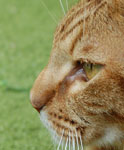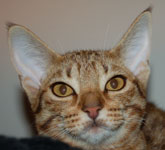The Ocicat has all the trademarks of a wild cat. It's character, however, is the complete opposite.
They have a great adaptability. They are feeling home in an appartment or in a house with a safe fenced-off garden or catrun.
Social behaviour and adaptability
They are extremely people-oriented, living well with children and people of all ages and types. Their sociable nature may make them less suited than some other breeds to being left alone for long periods on a regular basis, but it does make them a good choice for a household already blessed with other cats and dogs.
Ocicats are devoded, intelligent, playful, lively,curious active and most of the time playful but with a definately cuddle side to them.
Their adaptability also makes them ideal companion animals, whether you are a stay-at-home or frequent traveler in search of a travel companion. They do not display an aloof temperament and actually act more like a dog than a cat. In general, they get along well in groups and with individuals of other breeds as long as their personalities and energies do not conflict.
Sometimes an Ocicat is like a dominance cat. Some cats and people can be very impressed by the faraway look in their almond shaped eyes. Ocicats feel themselves to be superior and thats what you see.
Intelligence
The intelligence of the Ocicat is also intriguing.
Ocicats are quite bright and easily trained. There are times when Ocis are fully capable of opening doors or cage latches, Many will fetch a mouse (toy), walk on a leash, respond to whistled commands and readily adapt to household rules. They also listen to their names.
The Ocicat is a well-spotted cat of medium to large size, displaying the look of an athletic animal. They are well muscled and solid, graceful and lithe, yet with a fullness of body and chest. People are usually surprised when they first hold an Ocicat, as Ocicats are very heavy for their size. An Ocicats weight is primarily composed of muscle and great bone. Female Ocicats weigh between 3,5 to 5 kilo pounds. Male Ocicats weigh between 5 and 7 kilo and larger.
It is alert to its surroundings and shows great vitality. This powerful, athletic, yet graceful, spotted cat is particularly noted for its "wild appearance".
Head
Eyes
Ears
:
:
:
The skull is a modified wedge showing a slight curve from the muzzle to the cheeks, with a visible, but gentle rise from the bridge of the nose to the brows. Strong with a firm jaw with a proper bite.
Large, almond in shape, and angled slightly upwards towards the ears, with more than the length of an eye between the eyes All eye colours except blue are allowed. There is no correspondence between eye colour and coat colour. Intensive colour is preferred.
Alert, moderately large. Set so as to corner the upper, outside dimensions of the head.When present ear tufts extending vertically from the tips of the ears are a bonus.


While the Ocicat is not the only spotted breed, it is distinctively different in its spotting pattern. The Ocicat has thumbprint-shaped spots in a bullseye pattern on the torso.
There are broken necklases on the throat. The tail is fairly long, medium slim with only a slight taper and with a dark tip.
The lightest colour is usually found on the face around the eyes, on the chin and lower jaw. The darkest colour is found on the tip of the tail.
there are 12 accepted Ocicat colours: tawny, chocolate, cinnamon, blue, lavender (lilac) and fawn. These colours are also with a silver undercoat, and of course a lot of spots. Pictures of the colour coat of some of our Ocicats you can find below.












cinnamon silver
'Isis'
The origins of the Ocicat can be traced back to 1964, when Virginia Daly of Berkeley, she crossed a Seal Point Siamese and a Ruddy Abyssinian, in hopes of developing an Aby-pointed Siamese. The first generations of cats were phenotypically Abyssinian. A cross between one of these females and a Siamese produced not only the Aby-pointed Siamese, but also a spotted cat, Tonga, dubbed an "Ocicat" by Virginia's daughter, due to its resemblance to its wild cousin, the Ocelot. Tonga was neutered and sold as a pet.
Subsequent breedings of the sire, dam, and other Abyssinians and Siamese formed the foundation of the Ocicat breeding program. American Shorthairs were eventually added to introduce the silver color, placement of spots, and enhance size and boning.
The Ocicat was promoted to provisional status in the Cat Fanciers Association in 1986. At that time, the registry was closed to Siamese and American Shorthair outcrosses, although the use of Abyssinians is allowed until 2005. The Ocicat reached championship competition status in both CFA and TICA for the 1987 show season. The breed is recognized in all other registries as well.
In 1995 the first Ocicat named Galax Miss Finland was imported in the Netherlands by family Lensink.